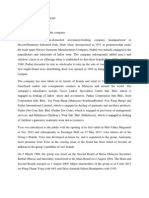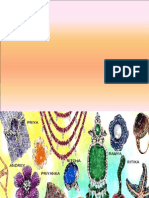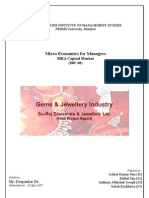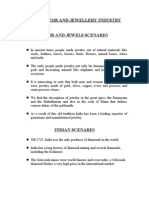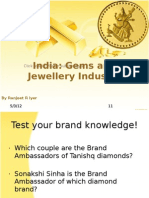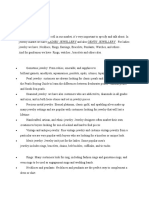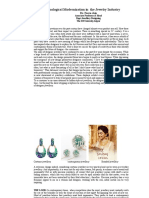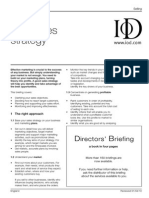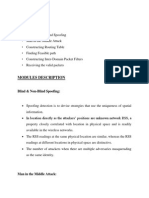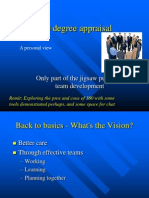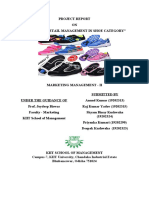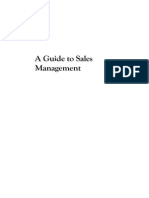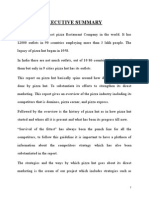Jewelry Marketing Plan
Jewelry Marketing Plan
Uploaded by
vikramnmbaCopyright:
Available Formats
Jewelry Marketing Plan
Jewelry Marketing Plan
Uploaded by
vikramnmbaOriginal Description:
Copyright
Available Formats
Share this document
Did you find this document useful?
Is this content inappropriate?
Copyright:
Available Formats
Jewelry Marketing Plan
Jewelry Marketing Plan
Uploaded by
vikramnmbaCopyright:
Available Formats
Jewelry Marketing Plan
Executive Summary
Contemporary Ti Design is a designer and manufacturer of unique titanium jewelry.
Contemporary Ti Design makes many designs in the form of earrings, pins, and
pendants. All of the products are designed and manufactured by Steve Artificer.
Each piece of jewelry is a work of art in itself, very special and unique. Most people
will feel that Steve's pieces are like nothing else they have ever seen. Steve will be
selling directly to end consumers through his website as well as at exhibitions/shows.
Steve will also use galleries, museum shops, and specialty jewelry retailers as a
distribution channel as well.
Steve will be operating Contemporary Ti Design out of his Hood River home. For the
first eight months Steve will be a one-man show. Steve will welcome an independent
sales representative on month eight to allow Steve to spend more time at home
designing and constructing.
Situation Analysis
Contemporary Ti Design is a start-up company operating out of the owner's
home. Marketing will be key to raise visibility and awareness of Contemporary Ti Design
and their products. The basic market need is for unusual pieces of art jewelry crafted out of
titanium. Titanium is used because of its hypoallergenic qualities (ideal for necklaces and
earrings that touch the skin), its incredible strength, and light weight.
Getting ready to create a marketing plan?
Get practical ideas and good models with dozens of examples of successful
marketing plans with Sales and Marketing Pro.
Finish your own Marketing Plan
Market Summary
Contemporary Ti Design has a lot of information regarding the market and attributes
concerning their target customers. This information will be leveraged to continually
determine who the customer is, their specific needs, and how Contemporary Ti Design can
best communicate with them.
Create or edit
this chart
Market Needs
Contemporary Ti Design is providing its customers with innovative, creative, handmade
jewelry. It will provide the following benefits to their customers:
Selection: A wide range of jewelry styles, creations, and anodizing schemes.
Accessibility: Ti design sells direct to the consumer, through a network of art/jewelry galleries,
and at art fairs and shows.
Customer service: The patron will be impressed with the level of attention and service that
they receive. This level of service occurs during all transactions with Ti designs from answering
questions, to order taking, to warranty repairs.
Competitive pricing: The pricing structure provides the consumer with a good value for
handmade jewelry and the craftsmen with a fair profit.
Market Trends
The market trend within the jewelry industry is a movement toward custom, unique pieces as
well as limited production items. This trend is in response to the climate of the industry in
the mid-nineties where the jewelry market was flooded with thousands of identical pieces of
jewelry. Within a few years, people were running into others who had the same piece of
jewelry. This element of commonality or "run of the mill-ness" fueled demand for artistic
jewelry that was in low production and unique, not something that you would see very often.
Customers are using similar pieces of jewelry as a way of creating distinction from the
common population, a way to stand out. This desire is part of a broader desire to be
different. Contemporary Ti Design has leveraged this trend by creating unique pieces that are
distinct.
Create or edit
this chart
Market Growth
The artistic jewelry segment of the larger jewelry industry is growing at a healthy 9%. This
growth can be attributed to the value that people place on having distinctive, unique pieces of
jewelry.
Another factor that is supporting the growth is the blending of art and jewelry. Traditionally
jewelry was ornate pieces made out of precious metals. The nice pieces were a symbol of
wealth or status. As long as the piece was made out of a precious metal, there was value
attributed to the piece just by virtue of what it was made out of, regardless of the creativity of
the actual piece. The younger population that recognizes the aesthetic value of art work is
now demanding jewelry to have artistic elements. In essence it is art that you wear. These
trends are helping the industry grow.
Create or edit
this chart
SWOT Analysis
The following SWOT analysis captures the key strengths and weaknesses within the
company, and describes the opportunities and threats facing Contemporary Ti Design.
Strengths
Unique designs and construction methods.
Strong relationships with suppliers as well as galleries.
The flexibility to provide custom pieces.
A comprehensive distribution network from a robust website and a network of galleries.
Weaknesses
A large portion of the target market that is unaware of Contemporary Ti Design's products.
Limited time and budget to market the company to the segmented target population.
The struggle to constantly create new designs.
The possible inability to meet demand due to the small size of the company.
Opportunities
A growing market that, to a large degree, is unaware of Contemporary Ti Design.
The possibility to grow the size of the company so Steve is spending his time creating and allowing
others to deal with the administrative details.
The injection of fresh, creative designs in a somewhat stagnant industry.
Threats
A decrease of availability of raw materials due to demand from other industries.
Artistic copycats that enter the market and mimic Steve's designs.
A slowdown of the economy that will have a reduction on individual's discretionary income.
Competition and Buying Patterns
As previously stated the jewelry industry is composed of thousand upon thousands of people.
Some work and distribute locally, others have national distribution systems set up. Some
artists will design products for larger companies to manufacture, others will design and make
the pieces themselves. This plan will have an abridged competition section. This is because of
the very large and distributed nature of artisan jewelry design, the market is entirely too
dispersed to have a complete catalog of the competition.
Competition takes the following forms:
Artists creating designs that are manufactured on a large scale and distributed nationally. The artists
might be famous enough to have their own one-name studio that creates designs and the product is
made and sold under the larger companies name. If the artist is not famous enough to have national
name recognition, the designers might belong to a firm that is hired to develop designs for a company
who will manufacture and sell the product.
A company that has their own designers in-house. In this case everything is done internally, design,
marketing and wholesaling. Another variation would be in-house designers, marketers and
wholesalers with the manufacturing contracted out.
Artists such as Steve who design and make all of the pieces themselves, and then do the wholesaling
or retailing themselves. In essence, one-man shows.
The buying patterns of consumers fall typically into two types. Gifts and impulse purchases.
A gift purchase occurs when the buyer is looking for a gift for someone, sees the art piece,
and then purchases it. In this case the plan is to make a purchase, it is just not known what or
where that purchase will be made. The other buying pattern is an impulse purchase. Someone
will be shopping, they are not in need of anything, will see the item and have to have it,
buying it on the spot. One last pattern, that occurs less frequently is if someone was looking
for an "accessory" that would match an outfit and happens to come across the piece of
jewelry and buys it.
Product Offering
Contemporary Ti Design manufactures titanium jewelry. The jewelry takes the form of
pendants, earrings, and pins. All of the jewelry is made out of titanium. All of the products
are designed and made by Steve.
Steve has chosen titanium because of its unique characteristics. It is stronger than steel, yet
similar in weight to aluminum. It is inert and hypoallergenic.
Most of the jewelry is left unfinished. The gray of the titanium by itself looks quite nice.
Some of the pieces are anodized. Anodizing adds a broad range colors to the titanium.
Anodizing occurs by immersing the titanium in electrically charged water or hooking up the
titanium to a electrical power source. When charged with electricity, a light film or oxide will
form on the surface of the titanium and this produces color.
Contemporary Ti Design's pieces are constructed out of titanium sheets. The material is cut
using a saw blade. The interior of the pieces are cut by piercing a small hole through the
interior and inserting a saw blade. All pieces are made form several pieces of titanium. The
pieces are held together by rivets. Small holes are drilled through the different pieces and a
small wire (rivet) is inserted through. The head and end of the rivet is tapped with a hammer
and that enlarges the end holding the pieces together. In addition to the utility of the rivet, it is
aesthetically pleasing in terms of the overall look of the piece.
Keys to Success
Customer service.
Unique designs.
Creativeness.
Professionalism.
Critical Issues
Contemporary Ti Design is still in the speculative stage as a start-up venture. Its critical
issues include continuing to take a modest fiscal approach, expanding at a reasonable rate, not
for the sake of expansion in itself, but because it is economically wise to. Contemporary Ti
Design will continue to build brand awareness to assure growth in the customer and gallery
base.
Marketing Strategy
Contemporary Ti Design will rely on three forms of marketing activities. The first will be
attendance (including promotion with a booth) at the various art shows and festivals through
out the country. This form of marketing/promotion is an efficient way to reach target
customers as well as generate sales at these events.
A second form of marketing is the use of the website which will be a source to disseminate
information, increase visibility, and process orders. The website will be submitted to various
search engines so people that are not even looking specifically for Contemporary Ti Design
will come across the site.
A third source of marketing will be networking and promotion through the network of
art/jewelry galleries. Initially Steve will be generating relationships with galleries.
Contemporary Ti Design will visit numerous galleries in many major cities and recruit them
to sell Steve's product. While the margins are smaller than if Contemporary Ti Design sells
the piece direct, the galleries will help significantly increase the volume of sales.
Getting ready to create a marketing plan?
Get practical ideas and good models with dozens of examples of successful
marketing plans with Sales and Marketing Pro.
Finish your own Marketing Plan
Mission
Contemporary Ti Design's mission is to make innovative pieces of art in jewelry using
titanium. We exist to attract and maintain customers through creative designs and customer
attention. When we adhere to this maxim, everything else will fall into place. Our services
will exceed the expectations of our customers.
Marketing Objectives
Increase the number of participating galleries by 8% a quarter after year one.
Increase Web traffic and sales by 5% each month.
Increase the amount of sales relative to marketing expenses steadily every quarter.
Financial Objectives
A 15% increase in productivity.
A decrease in variable costs through operating efficiencies.
An increase in sales, enough to warrant the hiring of additional people to take on administrative
details, allowing Steve to concentrate on his art work.
Target Markets
Contemporary Ti Design will be focusing on two distinct groups of customers: the end
consumer, and galleries (galleries to be used as a distribution channel). The end consumer
will be interacting with Steve via his website as well as through personal contact at
exhibitions/shows. The galleries (also museum shops, jewelry stores) will also be met
through the exhibitions and shows. At these events a long-term relationship will be entered
into so that the shops become a retail distribution channel for Contemporary Ti Design.
Additionally, Contemporary Ti Design will be traveling the country meeting with different
galleries and setting up retailing relationships with them.
Positioning
Contemporary Ti Design will position itself as a creative constructor of artistic titanium
jewelry. Collectors of artistic jewelry will appreciate Contemporary Ti Design's unique
approach to wearable art.
Contemporary Ti Design will leverage its competitive edge:
It is based on creative, unusual designs. While this strategy can be replicated, it is not easy. Creative,
unusual designs require skill.
Steve is very skilled in what he does, and every piece that he manufactures incorporates an element of
creative, unusual, eye-catching design that stands out from most jewelry.
Strategies
The single objective is to position Contemporary Ti Design as an innovative, unique artistic
jeweler. This positioning is for the entire United States, the geographic region that
Contemporary Ti Design seeks to serve. The marketing strategy will seek to create customer
awareness regarding unique products offered, develop the customer base, and work toward
building a network of galleries as distributors.
The message that Contemporary Ti Design will communicate is that Ti Designs is a unique,
custom craftsmen of artistic jewelry. This message will be communicated through a variety
of methods. The first is through promotion and sales at various art shows and festivals
throughout the country. This method will be useful as it carefully targets one segmented
target population.
Another method will be the building of a gallery network that will serve as a distributor for
Ti's designs. Once this is established, this will be an effective sales outlet. The last method
for communicating Ti Design's positioning message is through their website. This website
will provide unlimited geographic coverage and is a wealth of information regarding all of
Steve's products. Additionally, it will serve as a mechanism for order placement.
Marketing Mix
Contemporary Ti Design's marketing mix is comprised of the following approaches to
pricing, distribution, advertising and promotion, and customer service.
Pricing: The pricing scheme will be based on the cost of the raw materials and the amount of time
required to construct the piece.
Distribution: The products will be distributed via the website, at the booth that Ti Designs mans,
and through a network of galleries.
Advertising and Promotion: The avenues of distribution will also serve as the methods for
advertising and promotion.
Customer Service: Obsessive customer attention is the mantra. Ti's philosophy is complete
customer satisfaction. This will occur at whatever cost. Even if this does not make sense relative to
short-term profits it will be done, recognizing that this attitude will only bolster long-term business
health.
Marketing Research
During the initial phases of the marketing plan development, several focus groups were held
for both consumers of artistic jewelry as well as buyers from galleries. These focus groups
provided useful insight into the decision making process of these target customers.
Steve also spent two months on the road participating in various art shows and festivals with
many different prototype pieces. This road show occurred to determine customer acceptance
of the product as well as to gauge demand. This information was then analyzed to determine
business feasibility.
The last source of marketing research involves road show and surveys that were handed out
at the fairs and shows. The purpose of the survey was to collect information regarding buyers
preferences, likes and dislikes regarding the designs, and price preferences of the products.
Financials
This section will offer a financial overview of Contemporary Ti Design as it related to the
marketing activities. Ti will address break-even analysis, sales forecasts, expense forecasts,
and how those link to the marketing strategy.
Getting ready to create a marketing plan?
Get practical ideas and good models with dozens of examples of successful
marketing plans with Sales and Marketing Pro.
Finish your own Marketing Plan
Break-even Analysis
The Break-even Analysis indicates that $4,000 is needed in monthly revenue to reach the
break-even point.
Create or edit
this chart
Break-even Analysis
Create or edit this table
Break-even Analysis
Monthly Revenue Break-even $3,411
Assumptions:
Average Percent Variable Cost 32%
Estimated Monthly Fixed Cost $3,400
Sales Forecast
The first month will be spent setting up the work quarters and building inventory. There will
be no sales. The second month will be spent traveling visiting galleries trying to set up
distribution channels. There will be no sales activity in month two as well. Month three will
mark the first month of sales activity. Steve will have been to exhibits and sold products, as
well as sales through the website. From month three on sales will increase
incrementally. Steve will be on the road usually about a week per month traveling to
galleries and exhibits. This will occur till month eight. Month eight will mark the time when
Steve will hire a sales representative to do the traveling to set up distributors and attend
exhibitions to allow Steve to concentrate on his design and production. Month eight will
mark a larger increase in sales.
Create or edit
this chart
Sales Forecast
Create or edit this table
Sales Forecast
2001 2002 2003
Sales
Retailers (galleries) $21,566 $38,874 $45,785
Individuals $17,708 $23,545 $29,874
Total Sales $39,274 $62,419 $75,659
Direct Cost of Sales 2001 2002 2003
Retailers (galleries) $6,939 $5,831 $6,868
Individuals $5,646 $3,532 $4,481
Subtotal Direct Cost of Sales $12,584 $9,363 $11,349
Expense Forecast
Marketing expenses are to be budgeted accordingly:
Art shows and art festivals: these expenses will ramp up around the ten major shows throughout the
year. Expenses will include travel costs, booth construction, and entry/promotion fees.
Website: these expenses will be fairly flat the entire year and go to the maintenance of the site.
Gallery promotion: these expenses are primarily travel and networking expenses and will vary month
to month depending when trips are scheduled.
Create or edit
this chart
Marketing Expense Budget
Create or edit this table
Marketing Expense Budget
2001 2002 2003
Art shows and festivals $3,400 $4,000 $4,500
Website $900 $900 $900
Other $850 $1,300 $1,600
------------ ------------ ------------
Total Sales and Marketing Expenses $5,150 $6,200 $7,000
Percent of Sales 13.11% 9.93% 9.25%
Controls
The purpose of Contemporary Ti Design's marketing plan is to serve as a guide for the
organization. The following areas will be monitored to gauge performance:
Revenue: monthly and annual.
Expense: monthly and annual.
Repeat business.
Customer satisfaction.
Word of mouth referrals
Getting ready to create a marketing plan?
Get practical ideas and good models with dozens of examples of successful
marketing plans with Sales and Marketing Pro.
Finish your own Marketing Plan
Implementation
The following milestones identify the key marketing programs. It is important to accomplish
each one on time, and on budget.
Milestones
Create or edit this table
Milestones
Advertising Start Date End Date Budget Manager Department
Marketing plan completion 1/1/2001 2/1/2001 $0 Steve Department
Website completion 1/1/2001 2/1/2001 $900 Steve Department
Art show/festival activities 1/1/2001 ongoing $3,400 Steve Department
Gallery networking 1/1/2001 ongoing $900 Steve Department
Name me 1/1/2003 1/15/2003 $0 ABC Department
Name me 1/1/2003 1/15/2003 $0 ABC Department
Name me 1/1/2003 1/15/2003 $0 ABC Department
Name me 1/1/2003 1/15/2003 $0 ABC Department
Name me 1/1/2003 1/15/2003 $0 ABC Department
Other 1/1/2003 1/15/2003 $0 ABC Department
Total Advertising Budget $5,200
PR Start Date End Date Budget Manager Department
Name me 1/1/2006 1/15/2006 $0 ABC Department
Name me 1/1/2006 1/15/2006 $0 ABC Department
Name me 1/1/2006 1/15/2006 $0 ABC Department
Other 1/1/2006 1/15/2006 $0 ABC Department
Total PR Budget $0
Direct Marketing Start Date End Date Budget Manager Department
Name me 1/1/2006 1/15/2006 $0 ABC Department
Name me 1/1/2006 1/15/2006 $0 ABC Department
Name me 1/1/2006 1/15/2006 $0 ABC Department
Other 1/1/2006 1/15/2006 $0 ABC Department
Total Direct Marketing Budget $0
Web Development Start Date End Date Budget Manager Department
Name me 1/1/2006 1/15/2006 $0 ABC Department
Name me 1/1/2006 1/15/2006 $0 ABC Department
Name me 1/1/2006 1/15/2006 $0 ABC Department
Other 1/1/2006 1/15/2006 $0 ABC Department
Total Web Development Budget $0
Other Start Date End Date Budget Manager Department
Name me 1/1/2006 1/15/2006 $0 ABC Department
Name me 1/1/2006 1/15/2006 $0 ABC Department
Name me 1/1/2006 1/15/2006 $0 ABC Department
Other 1/1/2006 1/15/2006 $0 ABC Department
Total Other Budget $0
Totals $5,200
Contingency Planning
Difficulties and risks:
Problems generating visibility.
Change in customer preferences.
Inability to keep up with demand.
Worst case risks may include:
Determining the business cannot support itself on an ongoing basis.
Forced to sell assets to cover liabilities.
You might also like
- Sample Business PlanDocument17 pagesSample Business PlanNikita Garg95% (61)
- Feasibility Study of Jewelry ShopDocument35 pagesFeasibility Study of Jewelry ShopMike Rajas69% (16)
- Business Plan On Hand Made ItemsDocument42 pagesBusiness Plan On Hand Made ItemsShery Hashmi90% (60)
- Jewellery MarketingDocument99 pagesJewellery MarketingMichal Le Fou100% (2)
- Business Plan For Artificial JewelryDocument20 pagesBusiness Plan For Artificial Jewelryheena zubairNo ratings yet
- Custom Made Jeweler - Business PlanDocument39 pagesCustom Made Jeweler - Business Planfazins85% (13)
- Jewelry Store Business Plan KioskDocument27 pagesJewelry Store Business Plan Kioskmariyam100% (2)
- Silver Jewellery ProjectDocument64 pagesSilver Jewellery Projectmadeshmb83% (6)
- Business Plan in Jewelry FieldDocument18 pagesBusiness Plan in Jewelry FieldsimalauraNo ratings yet
- Marketing Plan For A JewelleryDocument50 pagesMarketing Plan For A Jewelleryandrolyanna60% (5)
- Business PlanDocument27 pagesBusiness Plansameer khanNo ratings yet
- Diamond DistributionDocument17 pagesDiamond DistributionMeena Aggarwal100% (1)
- Tanishq Brand AnalysisDocument32 pagesTanishq Brand AnalysisPrathama Deokar100% (2)
- Fashion Hub New DelhiDocument6 pagesFashion Hub New Delhidheepthi k babu100% (3)
- Assignment Padini Holdings Berhad 3-LatestDocument18 pagesAssignment Padini Holdings Berhad 3-LatestZakiah Abu Kasim50% (2)
- NTCC ReportDocument33 pagesNTCC ReportAkshit JhingranNo ratings yet
- Kohinoor JewellersDocument13 pagesKohinoor JewellersJavier GuerreroNo ratings yet
- Jewelry Gemstone Business PlanDocument9 pagesJewelry Gemstone Business PlanAreej Aslam100% (1)
- Business Plan For A Home Based Jewelry Business-Anurag SrivastavaDocument21 pagesBusiness Plan For A Home Based Jewelry Business-Anurag Srivastavasurbhi130688No ratings yet
- Nakshatrajewelryhemant 131123014002 Phpapp02Document7 pagesNakshatrajewelryhemant 131123014002 Phpapp02Meena Singh100% (1)
- Jewellery IndustryDocument73 pagesJewellery IndustrySahil100% (2)
- Jewelry PresentationDocument23 pagesJewelry Presentationmeena chaudhary50% (4)
- Jewelry 2004 Survey Questionnaire DraftDocument9 pagesJewelry 2004 Survey Questionnaire DraftshajihatimNo ratings yet
- Gems and JewelleryDocument56 pagesGems and Jewelleryvinay180575% (4)
- Customer Perception Towards Branded Jewelry in IndiaDocument46 pagesCustomer Perception Towards Branded Jewelry in Indiaalkanm750100% (1)
- Gems and Jewellery Final Project ReportDocument12 pagesGems and Jewellery Final Project Reportapi-371236771% (17)
- Customer Perception Towards Branded Jewelry in IndiaDocument16 pagesCustomer Perception Towards Branded Jewelry in IndiaBilal Ahmad50% (2)
- Jewellery Product Management ReportDocument58 pagesJewellery Product Management ReportSoumya Siddharth Rout50% (4)
- Silver JewelleryDocument73 pagesSilver JewellerySubramanya Dg100% (1)
- Jewellery Business Plan 3Document37 pagesJewellery Business Plan 3Sagar NisharNo ratings yet
- Jewelry Industry: Jewelry Designing Jewelry Manufacturing Diamond Grading GemologyDocument17 pagesJewelry Industry: Jewelry Designing Jewelry Manufacturing Diamond Grading GemologyUsha paliNo ratings yet
- Bussiness Start-Up PlanDocument6 pagesBussiness Start-Up PlanSnaibalqisNo ratings yet
- A Study On Consumer Changing Buying Behaviour From Gold Jewellery To Diamond JewelleryDocument9 pagesA Study On Consumer Changing Buying Behaviour From Gold Jewellery To Diamond JewellerynehaNo ratings yet
- Company Description: Scope and Limitations of The Business (Transfer This To Marketing Plan-Marketing Area)Document2 pagesCompany Description: Scope and Limitations of The Business (Transfer This To Marketing Plan-Marketing Area)Chara etangNo ratings yet
- Great Time To Be A Woman". The Communication Was On AirDocument8 pagesGreat Time To Be A Woman". The Communication Was On AirAkanksha GoyalNo ratings yet
- Jewelry Retail BusinessDocument6 pagesJewelry Retail BusinessSydney MittoNo ratings yet
- Steph Business PlanDocument17 pagesSteph Business PlanVictor ImehNo ratings yet
- Tanishq Vs GiliDocument21 pagesTanishq Vs Giliblue_devil8132409No ratings yet
- Tanishq Visual MerchandisingDocument5 pagesTanishq Visual MerchandisingAnkit MehtaNo ratings yet
- Basic Knowledge of Silver & GoldDocument4 pagesBasic Knowledge of Silver & GoldShashi Bisht83% (6)
- Top Tips For Selling Jewelry PDFDocument13 pagesTop Tips For Selling Jewelry PDFEnescu GeorgeNo ratings yet
- Business Plan For Lufcook JewelryDocument37 pagesBusiness Plan For Lufcook JewelryIbrahim AbdulazizNo ratings yet
- Jewellery MarketDocument13 pagesJewellery MarketPrathish JosephNo ratings yet
- A Comparative Study On The Consumer's Preference Towards Branded Jewellery Over Non Branded Jewellery in MumbaiDocument44 pagesA Comparative Study On The Consumer's Preference Towards Branded Jewellery Over Non Branded Jewellery in Mumbaiabhijit05567% (6)
- Indian Gems and Jewellery IndustryDocument12 pagesIndian Gems and Jewellery IndustryAbhishek Jha100% (1)
- Tanishq JewellersDocument54 pagesTanishq JewellersAssassin129580% (5)
- An Analysis of The Gems & Jewellery Industry in IndiaDocument43 pagesAn Analysis of The Gems & Jewellery Industry in IndiaRanjeet Ramaswamy Iyer100% (4)
- Gems & JewelleryDocument45 pagesGems & JewelleryNishtha Mishra100% (2)
- A Study of Gems and Jewellery ExportDocument64 pagesA Study of Gems and Jewellery ExportAjay Yadav80% (5)
- Gerald Gems & Jewelers (GGJ) : Executive SummaryDocument7 pagesGerald Gems & Jewelers (GGJ) : Executive SummaryGerald CrewsNo ratings yet
- 4 PsDocument4 pages4 PsrayNo ratings yet
- Project Report - Retail Feedback FormDocument50 pagesProject Report - Retail Feedback Formtinogonsalves_334165No ratings yet
- Jewellery Dissertation TopicsDocument7 pagesJewellery Dissertation TopicsBestWriteMyPaperWebsiteUK100% (1)
- ENTREPDocument13 pagesENTREPAndrea Jane T GarciaNo ratings yet
- Eastern JewelryDocument12 pagesEastern JewelryScribdTranslationsNo ratings yet
- Industry Insights: To Learn More About This ReportDocument32 pagesIndustry Insights: To Learn More About This ReportSanjay ThakkarNo ratings yet
- B Wall Marketing PlanDocument12 pagesB Wall Marketing Planapi-314199047No ratings yet
- Literature Review On Jewellery IndustryDocument6 pagesLiterature Review On Jewellery Industryxvrdskrif100% (1)
- Business Plan Group 9Document12 pagesBusiness Plan Group 9Hiền ĐặngNo ratings yet
- Technological Modernization in The Jewelry IndustryDocument5 pagesTechnological Modernization in The Jewelry IndustryDr. Neeru jainNo ratings yet
- Gift Fair 2020, IHGF 2020 ExhibitorsDocument33 pagesGift Fair 2020, IHGF 2020 ExhibitorsAnju SinghNo ratings yet
- GiliDocument19 pagesGiliKartik SharmaNo ratings yet
- Thesis On Jewellery ShopDocument5 pagesThesis On Jewellery Shopbk2j2x1a100% (2)
- Assignment ErythropoietinDocument4 pagesAssignment ErythropoietinvikramnmbaNo ratings yet
- Questionnaire For Client AcquisitionDocument4 pagesQuestionnaire For Client Acquisitionvikramnmba100% (1)
- Review of LiteratureDocument2 pagesReview of LiteraturevikramnmbaNo ratings yet
- Your Sales Strategy: Selling Directors' BriefingDocument4 pagesYour Sales Strategy: Selling Directors' BriefingvikramnmbaNo ratings yet
- QuestionnaireDocument6 pagesQuestionnairevikramnmbaNo ratings yet
- IPM February 2015 SecuredDocument84 pagesIPM February 2015 SecuredvikramnmbaNo ratings yet
- Modules:: Blind & Non-Blind SpoofingDocument4 pagesModules:: Blind & Non-Blind SpoofingvikramnmbaNo ratings yet
- 360 Degree Appraisal: Only Part of The Jigsaw Puzzle of Team DevelopmentDocument27 pages360 Degree Appraisal: Only Part of The Jigsaw Puzzle of Team DevelopmentvikramnmbaNo ratings yet
- N.Vikram: Career ObjectiveDocument2 pagesN.Vikram: Career ObjectivevikramnmbaNo ratings yet
- History of Indian JewelryDocument1 pageHistory of Indian JewelryvikramnmbaNo ratings yet
- Group - 2, Project Report On Retail ManagementDocument29 pagesGroup - 2, Project Report On Retail ManagementAnand Kumar100% (1)
- Spices and Aromatic Plants in MoroccoDocument17 pagesSpices and Aromatic Plants in Moroccoelm_lamraniNo ratings yet
- Project On Nirma LTD (Umang)Document48 pagesProject On Nirma LTD (Umang)Richa Sharma100% (1)
- Shalv 19229 SipDocument37 pagesShalv 19229 Sip1820 SHALV GUPTANo ratings yet
- Macro-Environmental AnalysisDocument5 pagesMacro-Environmental AnalysisnavielNo ratings yet
- Study of Retailers Preference Towards Itc Candyman and Candico CandiesDocument58 pagesStudy of Retailers Preference Towards Itc Candyman and Candico CandiesSonu NiaalNo ratings yet
- Garnier Project Final1Document30 pagesGarnier Project Final1King Nitin Agnihotri60% (10)
- FootwearDocument86 pagesFootwearKristine IbascoNo ratings yet
- Couponing MadnessDocument3 pagesCouponing MadnessShoppingTipsAndTricksNo ratings yet
- Case Summary Whole Foods and Wild OatsDocument2 pagesCase Summary Whole Foods and Wild Oats李昊洋No ratings yet
- 04 Facility LayoutDocument83 pages04 Facility Layoutsakali aliNo ratings yet
- Research On Women Buying BehaviourDocument10 pagesResearch On Women Buying BehaviourAliNo ratings yet
- Clinic PlusDocument2 pagesClinic Plusurvashi2501No ratings yet
- Tuscany CatalogDocument10 pagesTuscany CatalogAsmawi MohamadNo ratings yet
- Tommy Hilfiger (Company) - Wikipedia by Saturday Night and I Will Be Thankful and Grateful For Your Presence in My LifeDocument54 pagesTommy Hilfiger (Company) - Wikipedia by Saturday Night and I Will Be Thankful and Grateful For Your Presence in My Lifesaty anveshNo ratings yet
- Parravicini CHPT 1Document60 pagesParravicini CHPT 1CharleneKronstedtNo ratings yet
- Appendix E Sample Questionnaire FormDocument4 pagesAppendix E Sample Questionnaire FormPatrick Lawrence YeeNo ratings yet
- Tata Neu Plus OnePager 10aug22Document2 pagesTata Neu Plus OnePager 10aug22Bollywood ForeverNo ratings yet
- Retail AtmosphericsDocument12 pagesRetail AtmosphericsRohini RajagopalNo ratings yet
- Sample Business PlanDocument38 pagesSample Business PlanConsueloNo ratings yet
- First Store of Marks &spencer in United Kingdom:: Marks and Spencer PLC (Also Known As M&S) Is A BritishDocument11 pagesFirst Store of Marks &spencer in United Kingdom:: Marks and Spencer PLC (Also Known As M&S) Is A BritishsteffijasperNo ratings yet
- Pizza HutDocument59 pagesPizza HutMonaVatsNo ratings yet
- The Consumer and Shopper Journey FrameworkDocument91 pagesThe Consumer and Shopper Journey FrameworkBeto BiscestoNo ratings yet
- OMDocument3 pagesOMErlene LinsanganNo ratings yet
- Bir Ruling No. Vat-424-2022 - Philippine Vending To Peza Subject To VatDocument5 pagesBir Ruling No. Vat-424-2022 - Philippine Vending To Peza Subject To VatJohnallen MarillaNo ratings yet
- Fred David, Chapter 1 - The Nature of Strategic ManagementDocument35 pagesFred David, Chapter 1 - The Nature of Strategic ManagementAndre Santos100% (2)
- Pestel Swot Analyses-Silver CrossDocument5 pagesPestel Swot Analyses-Silver CrossykhjksNo ratings yet














